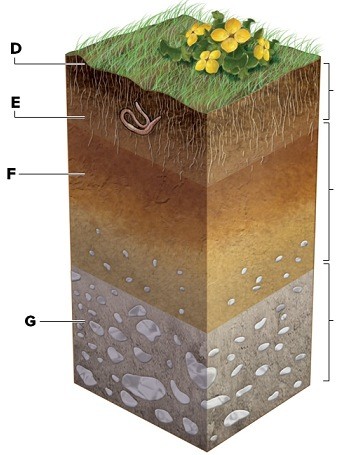Mature soil generally has three horizons. Label the soil horizons A, B, and C in the following picture. In addition, describe the contents of the horizons by labeling D through G.  D. ________E. ________F. ________G. ________
D. ________E. ________F. ________G. ________
What will be an ideal response?
Soil horizon A is the uppermost or topsoil layer. The B horizon is under A and the C horizon is a weathered rock layer under B.
D. Topsoil: contains litter and humus
E. Zone of leaching: removal of nutrients
F. Subsoil: accumulation of minerals and some organic material
G. Weathered or shattered rock
You might also like to view...
Which of the following produce N-formylmethionine as their first amino acid in protein synthesis?
a. Mercaria b. Archaea c. Bacteria d. Eukarya
Who observed cells in plant material?
a. Hooke b. Koch c. van Leeuwenhoek d. Lister e. Pasteur
Which of the following statements about the organs of balance and equilibrium is false?
A. The three semicircular canals of the vestibular apparatus function in dynamic equilibrium. B. At the base of each semicircular canal is a bulging region called the ampulla. C. The brain receives and integrates signals from the semicircular canals on both sides of the head. D. dynamic equilibrium allows you to keep your eyes locked on an object even when you swivel your head or nod. E. Organs in the saccule and utricle act in the sense of dynamic equilibrium.
What is the underlying problem in most acquired immunodeficiencies?
A. declining cell-mediated immunity B. declining humoral immunity C. production of autoantibodies D. eosinophilia E. anemia